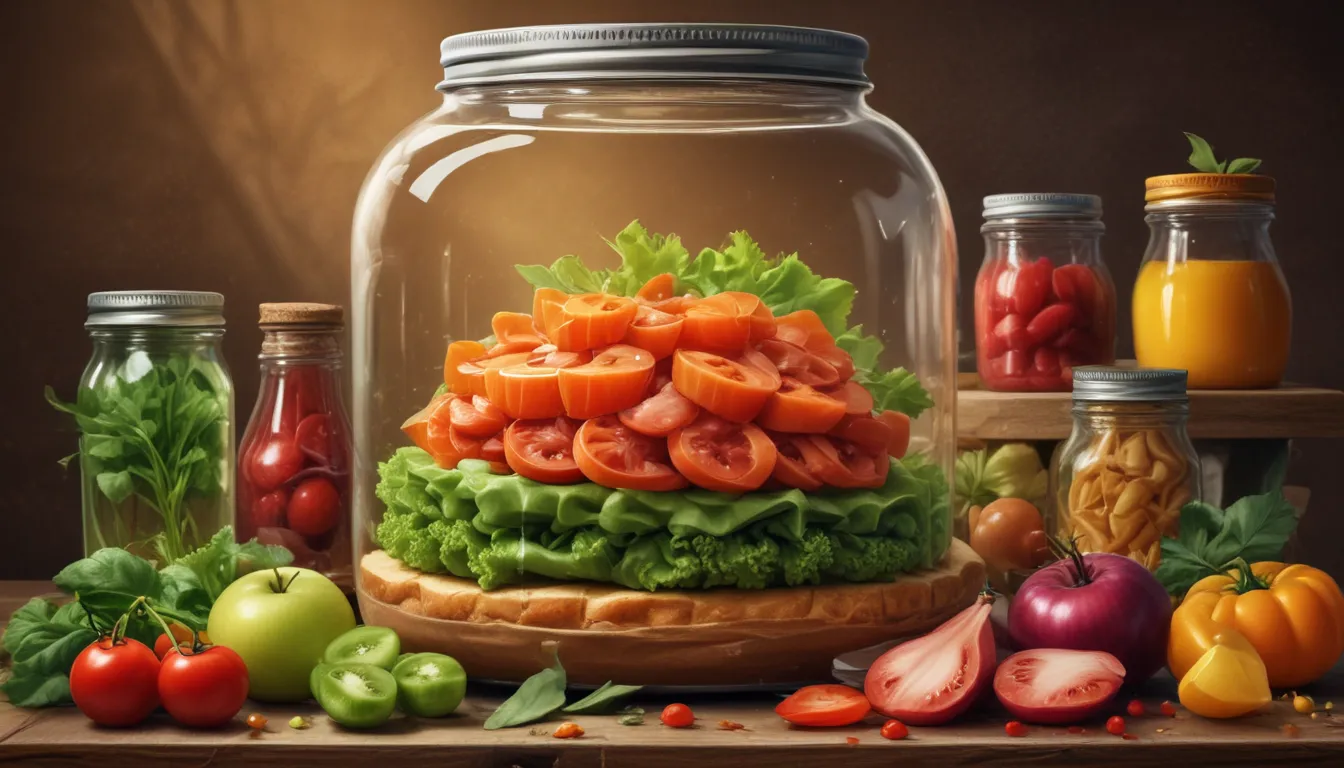A Note About Images: The images used in our articles are for illustration purposes only and may not exactly match the content. They are meant to engage readers, but the text should be relied upon for accurate information.
In the realm of food, the preservation of sustenance has long been a priority for humans. Through the ages, various techniques have been crafted to extend the lifespan of perishable items, ward off spoilage, and maintain a steady food supply. The evolution of food preservation methods has played a pivotal role in the survival and progression of societies.
Unveiling the Art of Food Preservation
Food preservation has been a vital practice since ancient times, with methods like salting, pickling, and smoking being instrumental in aiding people during times of scarcity. The ingenious techniques developed by civilizations have not only helped in preventing waste but have also paved the way for sustenance and prosperity.
The Mastery of Ancient Egyptians in Preservation
The earliest pioneers of food preservation, the Ancient Egyptians, were quick to grasp the significance of preserving food. By employing strategies such as salting and drying food under the blazing sun, they managed to stockpile provisions for extended periods. This foresight in preservation ensured their survival during challenging times.
The Revolutionary Impact of Canning
The 19th century marked a turning point in food preservation with the groundbreaking invention of canning by Nicolas Appert, a French chef. Canning involved sealing food in airtight containers and subjecting them to heat to eliminate bacteria. This innovation revolutionized the way people consumed food, enabling its transportation over vast distances.
Embracing the Power of Refrigeration
Prior to the introduction of mechanical refrigeration in the 19th century, perishable items were kept cold using ice and salt. The advent of domestic and commercial refrigeration units transformed food preservation by enhancing the shelf life of various food items. This shift reduced the reliance on preservatives and ensured the safe storage of a wide array of foods.
Exploring the Timeless Technique of Dehydration
Dehydration, a method that involves extracting moisture from food, has been in use for centuries. By inhibiting the growth of bacteria, yeast, and molds, dehydration has proven to be an effective way to preserve foods. This traditional technique is still prevalent today in the production of dried fruits, jerky, and powdered foods.
Unlocking the Magic of Salting
Salting, a technique that involves coating or immersing food in salt, has been a longstanding method of food preservation. The desiccating properties of salt draw out moisture from microorganisms, effectively thwarting spoilage. This method, employed for centuries, remains a popular way to preserve fish, meat, and vegetables.
Embracing the Tangy World of Pickling
Pickling, characterized by the preservation of food in acidic solutions like vinegar, serves as a means to extend the shelf life of various food items. The high acidity of the pickling solution creates an environment hostile to bacteria, preserving the food in a tangy state. Common examples of pickled foods include cucumbers, onions, and cabbage.
Preserving Freshness Through Freezing
Freezing, a widely adopted method of food preservation, halts microbial activity by slowing down or ceasing the growth of microorganisms responsible for spoilage. The ultra-low temperatures prevent the proliferation of bacteria, yeast, and molds, enabling foods to be stored for prolonged periods without compromising their nutritional value or taste.
Infusing Flavor Through Smoking
Smoking, an age-old preservation technique, imparts flavor to food while acting as a natural preservative. The antimicrobial properties present in the smoke from burning wood hinder the growth of bacteria. Apart from preservation benefits, smoking adds a distinct and savory flavor to the food, making it both delectable and enduring.
These intriguing facts shed light on the ingenuity and progression of humans in securing the availability of food throughout history. From the foundational practices of ancient civilizations to the innovative methods of today, food preservation continues to be a cornerstone in sustaining communities and broadening culinary boundaries.
Embracing the Legacy of Food Preservation
Food preservation techniques are not merely about extending the shelf life of edibles; they encompass a rich tapestry of tradition, innovation, and resourcefulness. Whether it’s canning, freezing, drying, or fermenting, each method offers a unique approach to preserving food, enhancing its flavors, and safeguarding its nutritional value.
Understanding and embracing these diverse food preservation techniques can yield multiple benefits, including reduced food waste, economic savings, and access to a wider array of ingredients. As you savor a jar of pickles, a bag of frozen fruits, or a slice of dried meat, take a moment to reflect on the fascinating history and science behind these preservation methods.
Frequently Asked Questions
Q: What is the oldest food preservation technique?
A: Drying, which involves removing moisture from food, stands as one of the oldest food preservation techniques, inhibiting bacterial growth and spoilage.
Q: Which food preservation technique is best for long-term storage?
A: Canning is deemed one of the most effective methods for long-term food storage, as it seals food in airtight containers to prevent bacterial contamination.
Q: Are there health risks associated with food preservation techniques?
A: While safe when executed correctly, improper canning techniques can lead to bacterial growth like Clostridium botulinum, potentially causing botulism. Adhering to proper guidelines and seeking expert advice is crucial.
Q: Can I freeze any type of food for preservation?
A: While freezing is a popular method, not all foods are suitable for freezing. Certain items, like lettuce or cucumbers, may lose texture and become mushy upon thawing. Researching specific foods before freezing is advisable.
Q: How does fermentation preserve food?
A: Fermentation, a natural preservation process involving the conversion of sugars by beneficial microorganisms, not only preserves food but also enriches its flavors and nutritional content. Examples include sauerkraut, kimchi, and yogurt.
Q: Can food preservation techniques alter the taste of preserved food?
A: Yes, some preservation techniques can influence the taste of food. For instance, pickling may impart a tangy, sour flavor, while smoking can add a smoky essence. These flavor enhancements contribute to the uniqueness of preserved foods.
Q: How do food preservation techniques promote sustainability?
A: Food preservation techniques aid in reducing food waste by prolonging the shelf life of perishable items. This decrease in constant production and transportation fosters a more sustainable and eco-friendly food system.
Q: Can I combine multiple food preservation techniques?
A: Absolutely! Many food items benefit from a hybrid approach to preservation. For instance, blanching fruits before freezing or dehydrating vegetables prior to canning can enhance longevity and flavor. Experimenting with different methods can lead to optimal preservation outcomes.
Exploring the realms of food preservation unveils a tapestry of traditions, innovations, and flavors. From the ancient civilizations of the past to the cutting-edge methods of today, the legacy of food preservation continues to shape culinary landscapes, promoting sustainability, diversity, and abundance. Embrace the art of preserving freshness and relish the bounty of flavors that exude from these timeless techniques.





